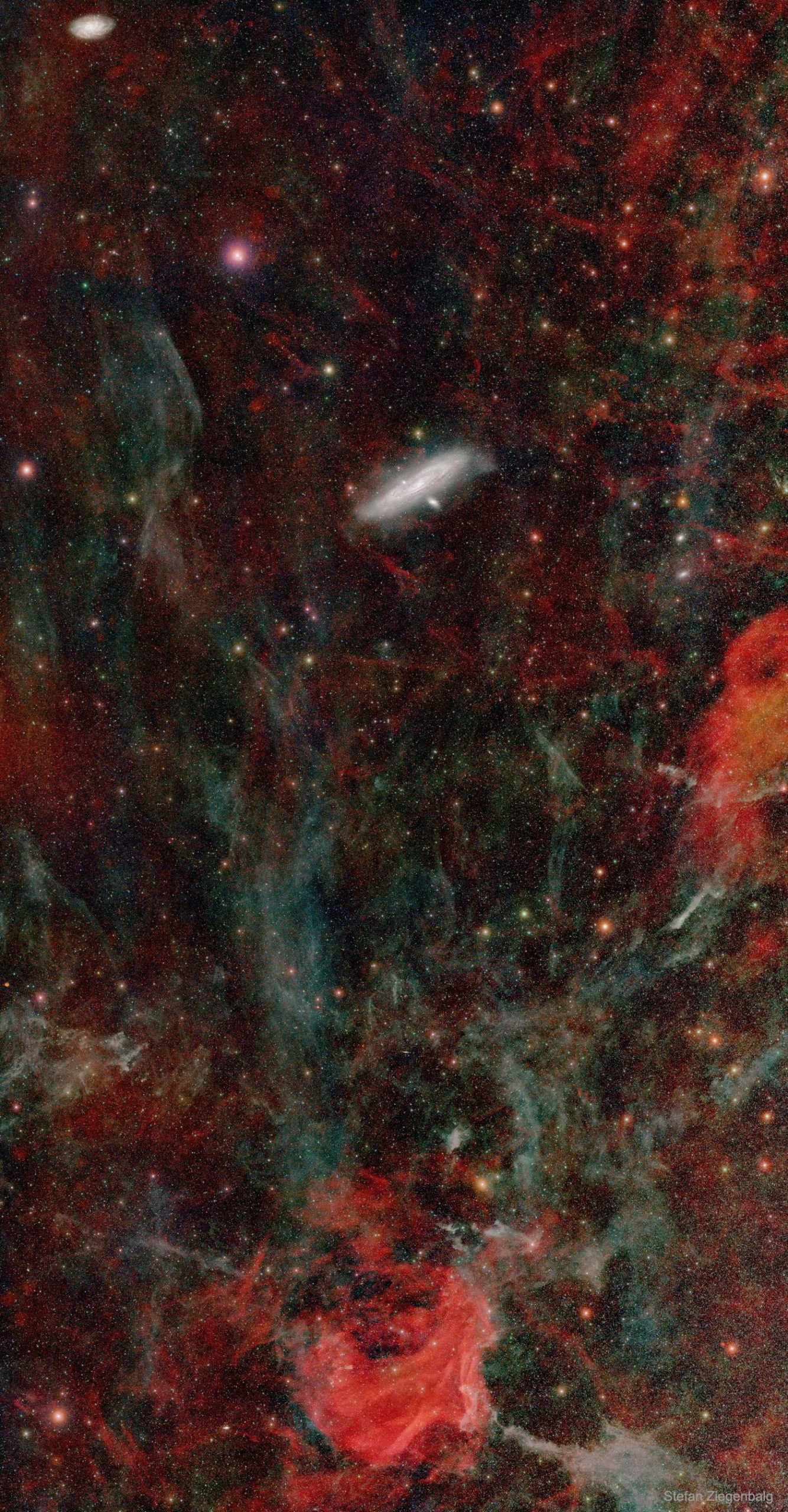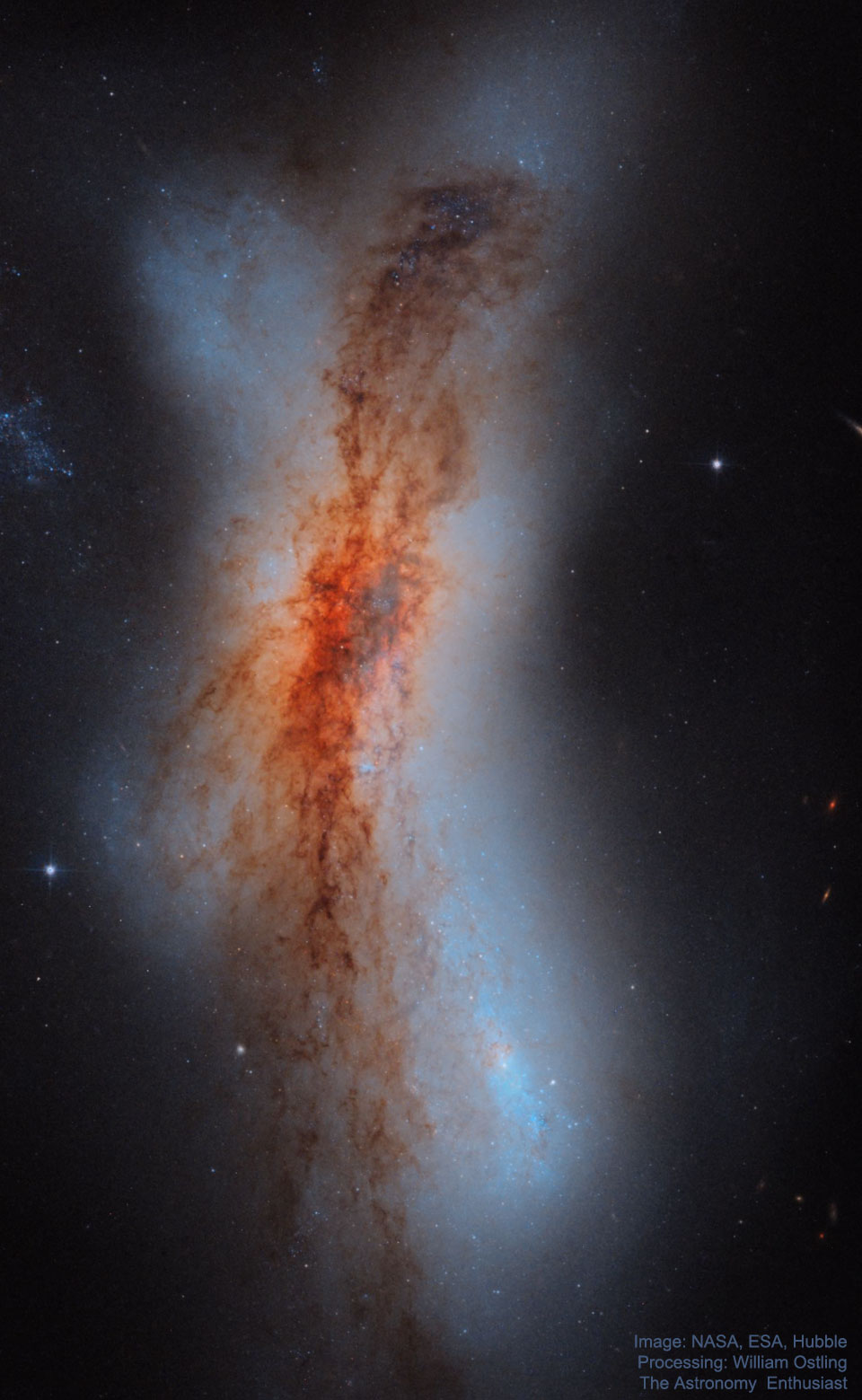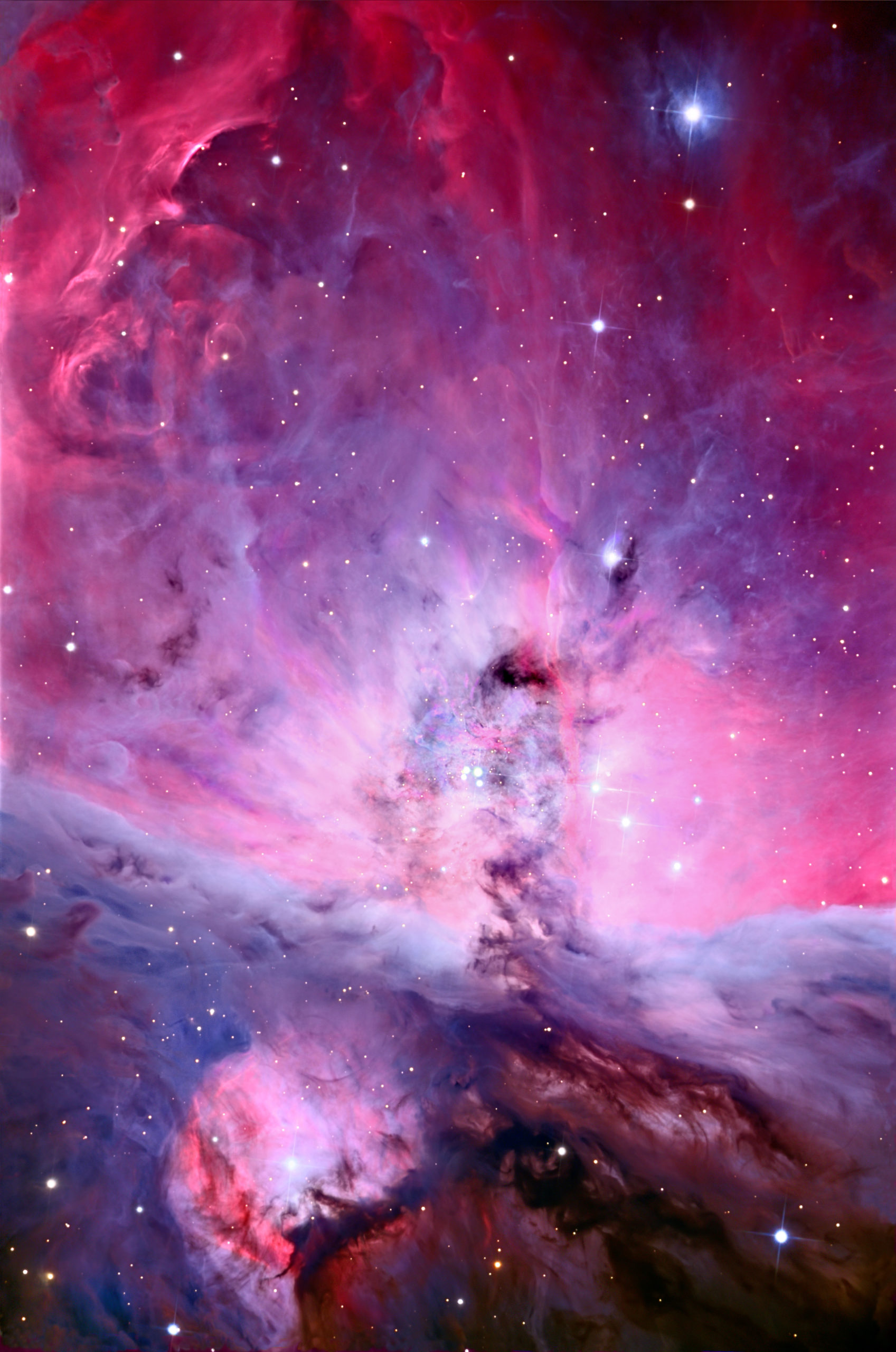Blog
Rhythm Roots Workshop will continue to delve into world rhythms arming soldiers with historic roots culture and celebrating diversity through music. Wednesday September 8th 2021 10am-noon. 7th in a series of 9. Working with the Memory Loss unit.

Out in space, Andromeda (M31) is closely surrounded by several small satellite galaxies, and further out it is part of the Local Group of Galaxies — of which our Milky Way galaxy is also a member. On the sky, however, gas clouds local to our Milky Way appear to surround M31 — not unlike how water clouds in Earth’s atmosphere may appear to encompass our Moon. The gas clouds toward Andromeda, however, are usually too faint to see. Enter the featured 45-degree long image — one of the deeper images yet taken of the broader Andromeda region. This image, sensitive to light specifically emitted by hydrogen gas, shows these faint and unfamiliar clouds in tremendous detail. But the image captures more. At the image top is the Triangulum galaxy (M33), the third largest galaxy in the Local Group and the furthest object that can be seen with the unaided eye. Below M33 is the bright Milky-Way star Mirach. The image is the digital accumulation of several long exposures taken from 2018 to 2021 from Pulsnitz, Germany.

Ronald Charles McKernan (September 8, 1945 – March 8, 1973), known as Pigpen, was an American singer and musician. He was a founding member of the San Francisco band the Grateful Dead and played in the group from 1965 to 1972.
McKernan grew up heavily influenced by African-American music, particularly the blues, and enjoyed listening to his father’s collection of records and taught himself how to play harmonica and piano. He began socializing around the San Francisco Bay Area, becoming friends with Jerry Garcia. After the pair had played in various folk and jug bands, McKernan suggested they form an electric group, which became the Grateful Dead. He was the band’s original frontman as well as playing harmonica and electric organ, but Garcia and bassist Phil Lesh‘s influences on the band became increasingly stronger as they embraced psychedelic rock. McKernan struggled to keep up with the changing music, causing the group to hire keyboardist Tom Constanten, with McKernan’s contributions essentially limited to vocals, harmonica, and percussion from November 1968 to January 1970. He continued to be a frontman in concert for some numbers, including his interpretations of Bobby Bland‘s “Turn On Your Love Light” and the Rascals‘ “Good Lovin’“.
Unlike the other members of the Grateful Dead, McKernan avoided psychedelic drugs, preferring to drink alcohol (namely whiskey and flavored fortified wine). By 1971, his health had been affected by alcoholism and liver damage and doctors advised him to stop touring. Following a hiatus, he resumed touring with the group in December 1971 but was forced to retire from touring altogether in June 1972. McKernan was found dead of a gastrointestinal hemorrhage on March 8, 1973, aged 27, and is buried at Alta Mesa Memorial Park in Palo Alto.
more...Charles “Specs” Wright (September 8, 1927 – February 6, 1963) was an American jazz drummer born in Philadelphia.
Wright played drums in an Army band until his discharge in 1947. Following this he played in a group with Jimmy Heath and Howard McGhee. In 1949 he joined Dizzy Gillespie‘s band alongside John Coltrane, remaining until it disbanded in mid-1950. Later in 1950 he was a member of Gillespie’s sextet with Coltrane, Jimmy Heath, Percy Heath, and Milt Jackson. In the 1950s, Wright played with Earl Bostic, Kenny Drew, Cannonball Adderley, Art Blakey, and Carmen McRae, and gigged locally in Philadelphia. He was with Hank Mobley in 1958 with his septet alongside Billy Root, Curtis Fuller, Ray Bryant, Tommy Bryant, and Lee Morgan. Following this Wright played with Sonny Rollins, Betty Carter, Red Garland, Coleman Hawkins, and Lambert, Hendricks and Ross. He died in 1963. He was interred in Beverly National Cemetery in Beverly, New Jersey.
more...Marion Brown (September 8, 1931 – October 18, 2010) was an American jazz alto saxophonist, composer, writer, visual artist, and ethnomusicologist. He was a member of the avant-garde jazz scene in New York City during the 1960s, playing alongside musicians such as John Coltrane, Archie Shepp, and John Tchicai. He performed on Coltrane’s landmark 1965 album Ascension. AllMusic reviewer Scott Yanow described him as “one of the brightest and most lyrical voices of the 1960s avant-garde.”
Brown, the grandson of an escaped slave from Georgia’s Sea Islands, was born in Atlanta in 1931 and was raised by a single mother. He began studying the saxophone at an early age, inspired by Charlie Parker. He left high school in the 10th grade and joined the army. During his three-year enlistment, he played alto saxophone, clarinet, and baritone saxophone, and was stationed in Hokkaido for some time. In 1956, he returned to Atlanta and enrolled at Clark College, where he studied music, taking lessons from Wayman Carver. After graduating, he moved to Washington, DC, where he enrolled at Howard University‘s law school. During this time, he began listening to musicians such as John Coltrane, Ornette Coleman, and Archie Shepp, all of whom he would soon meet and come to know.
more...Harmonica Fats (born Harvey Blackston, September 8, 1927 – January 3, 2000) was an American blues harmonica player who was active in the 1950s through to the 1990s. Fats first achieved success with his cover version of the Hank Ballard song “Tore Up” in 1962, which established him as an in-demand session and touring musician. He is also remembered for his collaboration with blues guitarist Bernie Pearl, a partnership that resulted in four albums.
Born in McDade, Louisiana, a small community 40 miles from Shreveport, Blackston, the eldest of 13 children, was raised on a cotton farm by his grandparents. Blackston casually played harmonica since he was four years-old, and credited Sonny Terry as the foremost influence on his style of playing. Bored with the farming lifestyle, in 1946 Blackston relocated to Los Angeles where he lived with his father, and worked for a manufacturing company. After an automobile accident in 1954 temporarily left him jobless, Blackston began avidly practicing his harp skills; recalling how he knew “a guy by the name of Cleveland Weller that plays guitar and he invited me out to his house to play on a Saturday night with him. So I went out there. He gave me a mike and an amplifier and I started blowing through that mike and amplifier and I would hear all my mistakes, and so then I went down town next day bought me a amplifier and a mike and so I went and practised for four months”.
more...Wilbur Bernard Ware (September 8, 1923 – September 9, 1979) was an American jazz double bassist. He was a regular bassist for Riverside in the 1950s, and recorded with J.R. Monterose, Toots Thielemans, Tina Brooks, Zoot Sims, and Grant Green.
Ware taught himself to play banjo and bass. In the 1940s, he worked with Stuff Smith, Sonny Stitt, and Roy Eldridge. He recorded with Sun Ra in the early 1950s. Later in the 1950s, settling in New York City, Ware played with Eddie Vinson, Art Blakey, and Buddy DeFranco. His only album recorded as a leader during his lifetime was The Chicago Sound, from 1957 when he worked for Riverside. He made jazz instructional albums for Music Minus One. In 1958, Ware was one of 57 jazz musicians to appear in the photograph A Great Day in Harlem.
Ware was a member of the Thelonious Monk quartet from 1957 to 1958. He also performed with the Sonny Rollins Trio live at the Village Vanguard.
Narcotics addiction resulted in his return to Chicago in 1963 and a period of incarceration. He was inactive musically for about six years. In 1969, Ware played with Clifford Jordan, Elvin Jonesand Sonny Rollins. He died from emphysema in Philadelphia, Pennsylvania, in 1979.
more...The jumble of stars, gas, and dust that is NGC 520 is now thought to incorporate the remains of two separate disk galaxies. A defining component of NGC 520 — as seen in great detail in the featured image from the Hubble Space Telescope — is its band of intricately interlaced dust running vertically down the spine of the colliding galaxies. A similar looking collision might be expected in a few billion years when our disk Milky Way Galaxy to collides with our large-disk galactic neighbor Andromeda (M31). The collision that defines NGC 520 started about 300 million years ago. Also known as Arp 157, NGC 520 lies about 100 million light years distant, spans about 100 thousand light years, and can be seen with a small telescope toward the constellation of the Fish (Pisces). Although the speeds of stars in NGC 520 are fast, the distances are so vast that the battling pair will surely not change its shape noticeably during our lifetimes.

Makanda Ken McIntyre (born Kenneth Arthur McIntyre; also known as Ken McIntyre) (September 7, 1931 – June 13, 2001)was an American jazz musician, composer and educator. In addition to his primary instrument, the alto saxophone, he played flute, bass clarinet, oboe, bassoon, double bass, drums, and piano.
McIntyre was born in Boston, Massachusetts, United States. His father played mandolin. McIntyre started his musical life on the bugle when he was eight years old, followed by piano. In his teens he discovered the music of Charlie Parker and began playing saxophone at nineteen, then clarinet and flute two years later. In 1953 he served in the Army and played saxophone and piano in Japan.
more...Charles Hardin “Buddy” Holley (September 7, 1936 – February 3, 1959 Lubbock, TX) was an American singer-songwriter who was a central and pioneering figure of mid-1950s rock and roll. He was born in Lubbock, Texas, to a musical family during the Great Depression, and learned to play guitar and sing alongside his siblings. His style was influenced by gospel music, country music, and rhythm and blues acts, which he performed in Lubbock with his friends from high school.
He made his first appearance on local television in 1952, and the following year he formed the group “Buddy and Bob” with his friend Bob Montgomery. In 1955, after opening for Elvis Presley, he decided to pursue a career in music. He opened for Presley three times that year; his band’s style shifted from country and western to entirely rock and roll. In October that year, when he opened for Bill Haley & His Comets, he was spotted by Nashville scout Eddie Crandall, who helped him get a contract with Decca Records.
Holly’s recording sessions at Decca were produced by Owen Bradley, who had become famous for producing orchestrated country hits for stars like Patsy Cline. Unhappy with Bradley’s musical style and control in the studio, Holly went to producer Norman Petty in Clovis, New Mexico, and recorded a demo of “That’ll Be the Day“, among other songs. Petty became the band’s manager and sent the demo to Brunswick Records, which released it as a single credited to “The Crickets“, which became the name of Holly’s band. In September 1957, as the band toured, “That’ll Be the Day” topped the US and UK singles charts. Its success was followed in October by another major hit, “Peggy Sue“.
The album The “Chirping” Crickets, released in November 1957, reached number five on the UK Albums Chart. Holly made his second appearance on The Ed Sullivan Show in January 1958 and soon after toured Australia and then the UK. In early 1959, he assembled a new band, consisting of future country music star Waylon Jennings (bass), famed session musician Tommy Allsup (guitar), and Carl Bunch (drums), and embarked on a tour of the midwestern U.S. After a show in Clear Lake, Iowa, he chartered an airplane to travel to his next show, in Moorhead, Minnesota. Soon after takeoff, the plane crashed, killing Holly, Ritchie Valens, The Big Bopper, and pilot Roger Peterson in a tragedy later referred to by Don McLean as “The Day the Music Died” in his song “American Pie“.
During his short career, Holly wrote and recorded many songs. He is often regarded as the artist who defined the traditional rock-and-roll lineup of two guitars, bass, and drums. He was a major influence on later popular music artists, including Bob Dylan, The Beatles, The Rolling Stones, Eric Clapton, The Hollies (who named themselves in his honor), Elvis Costello, Marshall Crenshaw (who later played Holly), and Elton John. He was among the first artists inducted into the Rock and Roll Hall of Fame, in 1986. Rolling Stone magazine ranked him number 13 in its list of “100 Greatest Artists”.
more...James Milton Campbell Jr. (September 7, 1934 – August 4, 2005), better known as Little Milton, was an American blues singer and guitarist, best known for his number-one R&B single “We’re Gonna Make It“. His other hits include “Baby, I Love You“, “Who’s Cheating Who?”, and “Grits Ain’t Groceries (All Around The World)“.
A native of the Mississippi Delta, Milton began his recording career in 1953 at Sun Records before relocating to St. Louis and co-founding Bobbin Records in 1958. It wasn’t until Milton signed to Checker Records that he achieved success on the charts. Other labels Milton recorded for include Meteor, Stax, Glades, Golden Ear, MCA, and Malaco. Milton was inducted into the Blues Hall of Fame in 1988.
Milton was born James Milton Campbell Jr. on September 7, 1934 in Inverness, Mississippi. He was raised in Greenville, Mississippi by a farmer and local blues musician. By age twelve he was a street musician, chiefly influenced by T-Bone Walker and his blues and rock and rollcontemporaries. He joined the Rhythm Aces in the early part of the 1950s, a three piece band who played throughout the Mississippi Deltaarea. One of the members was Eddie Cusic who taught Milton to play the guitar. In 1951, Milton recorded several sides backing pianist Willie Love for Trumpet Records.
more...Walter Theodore “Sonny” Rollins (born September 7, 1930) is an American jazz tenor saxophonist who is widely recognized as one of the most important and influential jazz musicians. In a seven-decade career, he has recorded over sixty albums as a leader. A number of his compositions, including “St. Thomas“, “Oleo“, “Doxy“, “Pent-Up House”, and “Airegin“, have become jazz standards. Rollins has been called “the greatest living improviser” and the “Saxophone Colossus”.
Rollins was born in New York City to parents from the United States Virgin Islands. The youngest of three siblings, he grew up in central Harlem and on Sugar Hill, receiving his first alto saxophone at the age of seven or eight. He attended Edward W. Stitt Junior High School and graduated from Benjamin Franklin High School in East Harlem. Rollins started as a pianist, changed to alto saxophone, and finally switched to tenor in 1946. During his high school years, he played in a band with other future jazz legends Jackie McLean, Kenny Drew, and Art Taylor.
more...https://www.youtube.com/watch?v=LFveprr7pUI
more...Michael Waller (6 September 1941 – 29 April 2008) was an English drummer, who played with many of the biggest names on the UK rock and blues scene, after he became a professional musician in 1960. In addition to being a member, albeit sometimes briefly, of some of the seminal bands of the 1960s, Waller played as a session musician with a host of UK and US artists and was famously known for never having a full drum kit whenever he turned up for recording sessions.
Waller was born in Hammersmith, London. Waller’s first professional band, The Flee-Rekkers, had a No. 23 hit in the UK Singles Chart in 1960, with their recording of “Green Jeans” produced by Joe Meek. He soon left to join a well-known band of the day, Joe Brown and the Bruvvers.
more...Charles Moffett (September 6, 1929 – February 14, 1997) was an American free jazz drummer.
Moffett was born in Fort Worth, Texas, where he attended I.M. Terrell High School with Ornette Coleman. Before switching to drums, Moffett began his musical career as a trumpeter. At age 13, he played trumpet with Jimmy Witherspoon, and later formed a band, the Jam Jivers, with fellow students Coleman and Prince Lasha. After switching to drums, Moffett briefly performed with Little Richard.
Moffett served in the United States Navy, after which he pursued boxing before studying music at Huston-Tillotson College in Austin. Moffett married in 1953 (Coleman was best man, and performed at the wedding), then began teaching music at a public school in Rosenberg, Texas
In 1961, Moffett moved to New York City to work with Ornette Coleman, but the saxophonist soon went into a brief retirement period. Moffett worked with Sonny Rollins, appeared on Archie Shepp‘s album Four for Trane, and led a group that included Pharoah Sanders and Carla Bley. When Coleman returned to performing in 1964, he formed a trio with Moffett and bassist David Izenzon.[1] Moffett also performed on vibraphone.
more...More Posts
- Trini López
- Oscar Castro-Neves
- Ellis Larkins
- World Drumming Babatunde Olatunji
- Daily Roots Delroy Wilson
- Cosmos NGC 2169
- David Byrne
- Jack Bruce
- Zutty Singleton
- World Music Doubt Gnahoré
- Daily Roots The Aggrovators
- Don’t Hate
- Devon Evans Update
- Rhythm Roots Workshop Ecumen North Branch Senior Living PERFORMANCE DAY
- Cosmos GUM 46
- Stevie Wonder
- Red Garland
- Gil Evans
- T. Balasaraswati
- World Drumming Babatunde Olatunji

